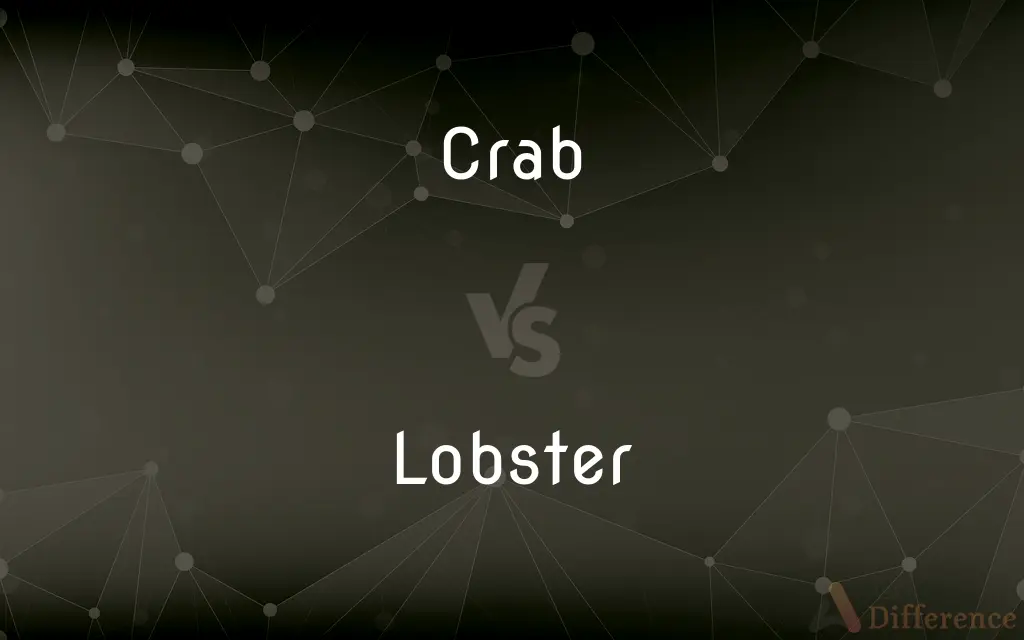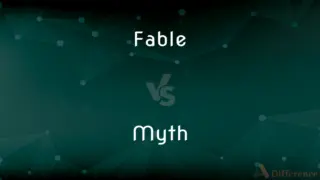Crab vs. Lobster — What's the Difference?
By Tayyaba Rehman — Updated on September 26, 2023
Crab and lobster are both crustaceans; crab has a shorter, broader body and walks sideways, while lobster has a longer body and large claws.

Difference Between Crab and Lobster
Table of Contents
ADVERTISEMENT
Key Differences
Crab and lobster are marine crustaceans with distinct anatomical structures and ecological roles in their respective habitats. Crabs are characterized by a broader, shorter body, and are renowned for their ability to walk sideways. They exhibit great diversity in size and inhabit various aquatic environments, including freshwater bodies. Lobsters, on the other hand, are recognized by their longer bodies and large, robust claws, and are primarily found in saltwater habitats. Both are valuable culinary delicacies, offering distinct flavors and textures to diverse cuisines worldwide.
Crabs and lobsters are harvested and consumed globally, but the culinary preparation and consumption methods vary widely. Crabs are often enjoyed for their sweet, tender meat found primarily in their claws and legs, and they can be cooked in numerous ways, including boiling, steaming, and baking. Lobsters are prized for their rich, succulent meat, particularly in the tail, and are typically boiled or grilled. Both crab and lobster dishes are considered gourmet food items, symbolizing luxury and opulence in many cultures.
Despite their culinary popularity, crab and lobster also play crucial ecological roles in maintaining the balance in aquatic ecosystems. Crabs are scavengers, feeding on algae, plankton, mollusks, and small fish, contributing to the nutrient cycling in aquatic environments. Lobsters, being omnivorous, consume a variety of sea creatures and plant life, aiding in controlling the population of their prey and promoting biodiversity in their habitats. The presence of these crustaceans is indicative of healthy, thriving marine ecosystems.
Economically, crab and lobster fisheries are substantial contributors to the global seafood industry. They are a significant source of income for many coastal communities, owing to the high demand in international markets. However, overfishing and unsustainable fishing practices threaten the populations of both crabs and lobsters, impacting marine biodiversity and the livelihoods dependent on them. Conservation efforts and sustainable fishing practices are crucial to preserving these species and maintaining ecological balance.
Comparison Chart
Body Shape
Shorter, broader body
Longer body with large claws
ADVERTISEMENT
Habitat
Various aquatic, including freshwater
Primarily saltwater
Economic Value
High, especially in coastal areas
Extremely high, luxury food item
Culinary Preference
Sweet, tender meat
Rich, succulent meat
Ecological Role
Scavenger, contributes to nutrient cycling
Omnivorous, promotes biodiversity
Compare with Definitions
Crab
A marine crustacean with a broad carapace, stalked eyes, and five pairs of legs.
The fisherman caught a large crab in his net today.
Lobster
Recognized by its long body and large, robust claws and primarily inhabits saltwater environments.
We saw a beautiful, red lobster while scuba diving in the ocean.
Crab
Plays a vital ecological role as a scavenger in marine ecosystems.
The presence of crab is crucial for maintaining balance in the marine ecosystem.
Lobster
A large marine crustacean with a cylindrical body, stalked eyes, and the first of its ten legs modified as large pincers.
He ordered a grilled lobster for dinner, savoring every bite of the succulent meat.
Crab
Crabs are decapod crustaceans of the infraorder Brachyura, which typically have a very short projecting "tail" (abdomen) (Greek: βραχύς, romanized: brachys = short, οὐρά / οura = tail), usually hidden entirely under the thorax. They live in all the world's oceans, in fresh water, and on land, are generally covered with a thick exoskeleton, and have a single pair of pincers.
Lobster
A symbol of luxury in culinary terms and is often considered a gourmet food item.
The lobster dish was the highlight of our luxurious dining experience.
Crab
Any of various chiefly marine decapod crustaceans of the infraorder Brachyura, having a hard carapace that covers a broad flattened cephalothorax with a small abdomen tucked beneath it, and an anterior pair of legs that are large and pincerlike.
Lobster
Known for its rich and succulent meat, especially found in its tail.
The lobster tail was cooked to perfection, bursting with flavors.
Crab
Any of various similar decapod crustaceans, such as a hermit crab or a king crab.
Lobster
Lobsters are a family (Nephropidae, sometimes also Homeridae) of large marine crustaceans. Lobsters have long bodies with muscular tails, and live in crevices or burrows on the sea floor.
Crab
Crabmeat.
Lobster
Any of several edible marine decapod crustaceans of the family Nephropidae, especially of the genus Homarus, having stalked eyes, long antennae, a pair of large pincers, and a cylindrical body.
Crab
A crab louse.
Lobster
Any of several similar crustaceans, such as a spiny lobster.
Crab
Crabs(Slang) Infestation by crab lice.
Lobster
The flesh of a lobster used as food.
Crab
The maneuvering of an aircraft partially into a crosswind to compensate for drift.
Lobster
To catch or try to catch lobsters.
Crab
A machine for handling or hoisting heavy weights.
Lobster
Red-colored, especially from a sunburn.
Red as a lobster
Crab
A crabapple tree or its fruit.
Lobster
A crustacean of the Nephropidae family, dark green or blue-black in colour turning bright red when cooked, with a hard shell and claws, which is used as a seafood.
Crab
A quarrelsome, ill-tempered person.
Lobster
A crustacean of the Palinuridae family, pinkish red in colour, with a hard, spiny shell but no claws, which is used as a seafood.
Crab
See Cancer.
Lobster
A soldier or officer of the imperial British Army (due to their red or scarlet uniform).
Crab
To hunt or catch crabs.
Lobster
(slang) An Australian twenty dollar note, due to its reddish-orange colour.
Crab
To scurry sideways in the manner of a crab.
Lobster
To fish for lobsters.
Crab
To drift diagonally or sideways, especially when under tow.
Lobster
Any large macrurous crustacean used as food, esp. those of the genus Homarus; as the American lobster (Homarus Americanus), and the European lobster (Homarus vulgaris). The Norwegian lobster (Nephrops Norvegicus) is similar in form. All these have a pair of large unequal claws. The spiny lobsters of more southern waters, belonging to Palinurus, Panulirus, and allied genera, have no large claws. The fresh-water crayfishes are sometimes called lobsters.
Crab
To direct an aircraft into a crosswind.
Lobster
As a term of opprobrium or contempt: A gullible, awkward, bungling, or undesirable person.
Crab
To direct (an aircraft) partly into a crosswind to eliminate drift.
Lobster
Flesh of a lobster
Crab
To cause to move or scurry sideways.
Lobster
Any of several edible marine crustaceans of the families Homaridae and Nephropsidae and Palinuridae
Crab
To find fault; criticize someone or something.
Lobster
Plays an essential ecological role by controlling the population of its prey in its habitat.
The healthy population of lobsters indicates a balanced and thriving marine environment.
Crab
(Informal) To interfere with and ruin; spoil.
Crab
(Informal) To find fault with; complain about.
Crab
To make ill-tempered or sullen.
Crab
A crustacean of the infraorder Brachyura, having five pairs of legs, the foremost of which are in the form of claws, and a carapace.
Crab
(uncountable) The meat of this crustacean, served as food; crabmeat.
Crab
A bad-tempered person.
Crab
An infestation of pubic lice (Pthirus pubis).
Although crabs themselves are an easily treated inconvenience, the patient and his partner(s) clearly run major STD risks.
Crab
The angle by which an aircraft's nose is pointed upwind of its groundtrack to compensate for crosswinds during an approach to landing; its crab angle.
The pilot had to hold fifteen degrees of crab during the approach to keep her plane from getting blown off the localizer course.
Crab
The state of an aircraft's nose being pointed upwind of its groundtrack to compensate for crosswinds during an approach to landing.
Crab
(slang) A playing card with the rank of three.
Crab
(rowing) A position in rowing where the oar is pushed under the rigger by the force of the water.
Crab
A defect in an outwardly normal object that may render it inconvenient and troublesome to use.
Crab
(dated) An unsold book that is returned to the publisher.
Crab
The crab apple or wild apple.
Crab
The tree bearing crab apples, which has a dogbane-like bitter bark with medical use.
Crab
A cudgel made of the wood of the crab tree; a crabstick.
Crab
A movable winch or windlass with powerful gearing, used with derricks, etc.
Crab
A form of windlass, or geared capstan, for hauling ships into dock, etc.
Crab
A machine used in ropewalks to stretch the yarn.
Crab
A claw for anchoring a portable machine.
Crab
The tree species Carapa guianensis, native to South America.
Crab
(informal) carabiner
Crab
(intransitive) To fish for crabs.
Crab
To ruin.
Crab
(intransitive) To complain.
Crab
(transitive) To complain about.
Crab
(intransitive) To drift or move sideways or to leeward by analogy with the movement of a crab.
Crab
To move in a manner that involves keeping low and clinging to surfaces.
Crab
To navigate (an aircraft, e.g. a glider) sideways against an air current in order to maintain a straight-line course.
Crab
To move (a camera) sideways.
Crab
, to fly slightly off the straight-line course towards an enemy aircraft, as the machine guns on early aircraft did not allow firing through the propeller disk.
Crab
(rare) To back out of something.
Crab
(obsolete) To irritate, make surly or sour
Crab
To be ill-tempered; to complain or find fault.
Crab
(British dialect) To cudgel or beat, as with a crabstick
Crab
One of the brachyuran Crustacea. They are mostly marine, and usually have a broad, short body, covered with a strong shell or carapace. The abdomen is small and curled up beneath the body.
Crab
The zodiacal constellation Cancer.
Crab
A crab apple; - so named from its harsh taste.
When roasted crabs hiss in the bowl,Then nightly sings the staring owl.
Crab
A cudgel made of the wood of the crab tree; a crabstick.
Crab
A movable winch or windlass with powerful gearing, used with derricks, etc.
Crab
To make sour or morose; to embitter.
Sickness sours or crabs our nature.
Crab
To beat with a crabstick.
Crab
To drift sidewise or to leeward, as a vessel.
Crab
Sour; rough; austere.
The crab vintage of the neighb'ring coast.
Crab
Decapod having eyes on short stalks and a broad flattened carapace with a small abdomen folded under the thorax and pincers
Crab
A quarrelsome grouch
Crab
(astrology) a person who is born while the sun is in Cancer
Crab
The fourth sign of the zodiac; the sun is in this sign from about June 21 to July 22
Crab
The edible flesh of any of various crabs
Crab
Infests the pubic region of the human body
Crab
A stroke of the oar that either misses the water or digs too deeply;
He caught a crab and lost the race
Crab
Direct (an aircraft) into a crosswind
Crab
Scurry sideways like a crab
Crab
Fish for crab
Crab
Complain;
What was he hollering about?
Crab
Known for its ability to walk sideways and is a popular seafood item.
We enjoyed a delicious crab dish at the seafood restaurant.
Crab
Can be found in various aquatic environments including freshwater.
We observed a small crab crawling along the riverbank.
Crab
Offers sweet and tender meat, primarily found in its claws and legs.
The crab meat was so sweet and flavorful, it didn’t need any sauce.
Common Curiosities
Are crabs found in freshwater environments?
Yes, crabs can be found in various aquatic environments, including freshwater.
How does the body shape of a crab differ from that of a lobster?
Crab has a shorter, broader body, while a lobster has a longer body with large claws.
Are crabs important for marine ecosystems?
Yes, crabs play a vital role as scavengers, contributing to nutrient cycling in marine ecosystems.
Which one is considered a luxury food item, crab or lobster?
Both are considered gourmet, but lobster is more often symbolized as luxury.
Which part of the lobster is most prized for its meat?
The tail of the lobster is most prized for its rich and succulent meat.
What is a crab?
A crab is a marine crustacean with a shorter, broader body, known for walking sideways.
What is a lobster?
A lobster is a marine crustacean, characterized by a long body and large, robust claws.
Do lobsters promote biodiversity in their habitats?
Yes, being omnivorous, lobsters aid in controlling the population of their prey, promoting biodiversity.
Share Your Discovery

Previous Comparison
Cloud vs. Sky
Next Comparison
Fable vs. MythAuthor Spotlight
Written by
Tayyaba RehmanTayyaba Rehman is a distinguished writer, currently serving as a primary contributor to askdifference.com. As a researcher in semantics and etymology, Tayyaba's passion for the complexity of languages and their distinctions has found a perfect home on the platform. Tayyaba delves into the intricacies of language, distinguishing between commonly confused words and phrases, thereby providing clarity for readers worldwide.














































